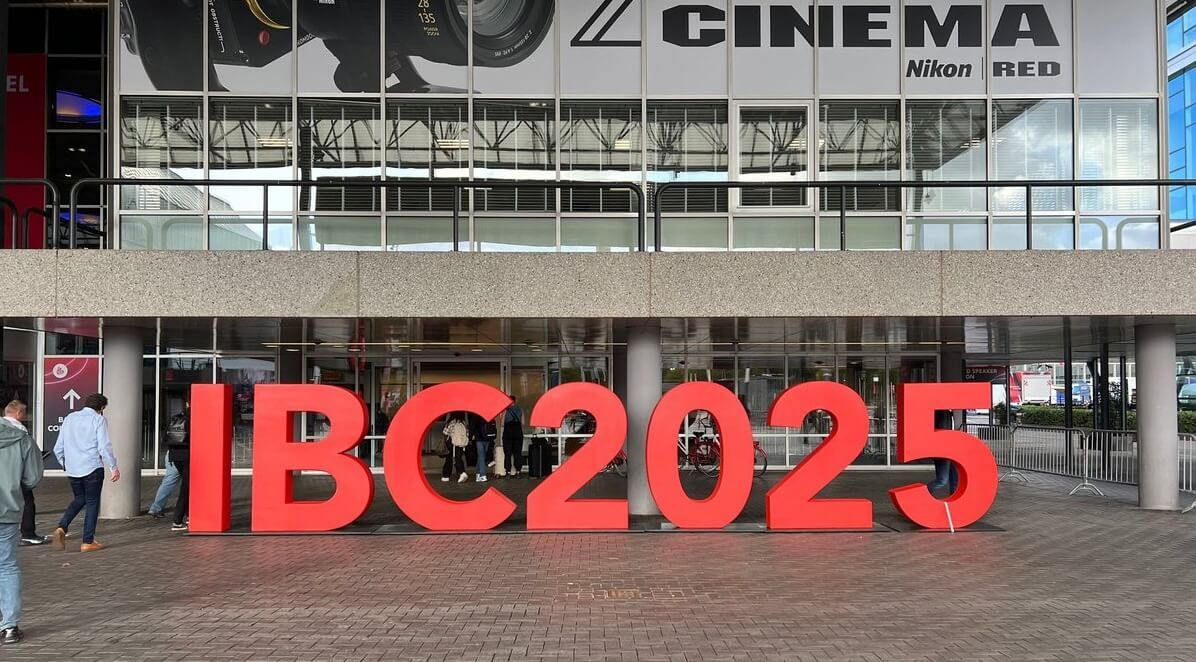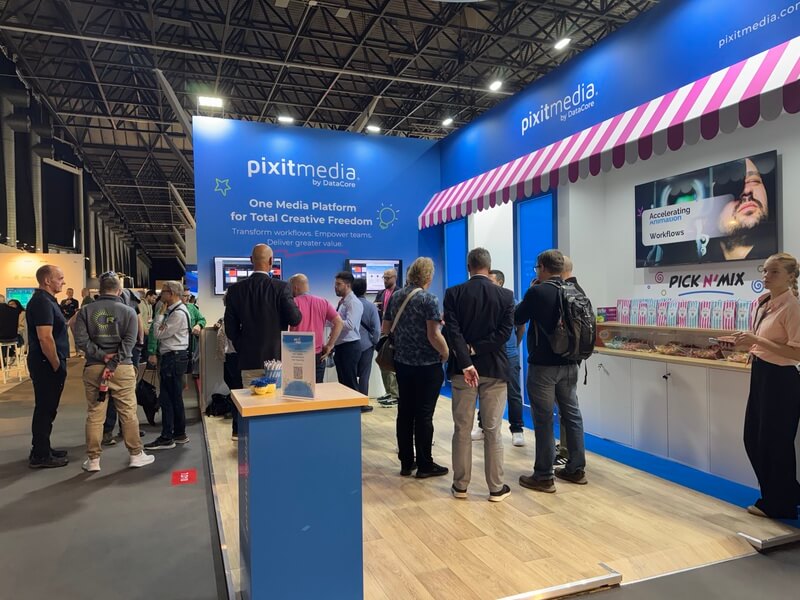
Interoperability, AI/ML, hybrid deployments, and parallel markets focused growth
Pixitmedia’s leadership, sales, marketing, and solution teams attended the IBC show in September 2025. We observed the following primary media archiving workflow trends on the conference stage and in meetings with key existing, and prospective customers (broadcast, and enterprises) with a presence on the show floor. Also, on our IBC booth we unveiled our flagship unified media archiving platform built on four core pillars (as highlighted below) transforming fragmented systems into a seamlessly converged TV & video ecosystem.

Courtesy: Pixitmedia Marketing Team
- Data management: Embracing open formats, and zero lock-ins easing data movement, and ownership,
- Orchestration: Tightly integrated and secure data transfer (includes event specific) accelerating time to market
- Discovery: Smart indexing, and metadata classification enhancing search across multi-faceted archiving systems streamlining the content verification process
- Collaboration: Unified exchange, and shared access across distributed teams, locations, and cloud lowering data silos.
Interoperability to accelerate remote distributed production throughput globally
In the past 2-3 years, the total volume of TV & film titles produced within the United States has witnessed a sharp decline of 40%. Furthermore, almost three out of four (70%) of TV & film content owners highlighted that remote distributed collaborative production is gradually becoming the norm due to cost synergies and sustainability (reduction in carbon footprint). Interoperability is pivotal to scale remote production across multiple distributed locations worldwide.
The growing pressures on multi-faceted production projects (live, on demand, linear, super aggregator apps) turnaround duration without offsetting performance need seamless integration of data movement, exchange, and access from anywhere. Also, as adoption of cloud-based archiving environments continues to rise, interoperable systems (especially legacy systems with agile workflows) are vital to enhance collaboration at scale. Media archiving vendors are embracing open industry standards, protocols, and formats along with robust third-party API integrations to assist in real-time frame-accurate review sessions with negligible lag, lower version confusion, and global collaboration on editing (comments, approvals etc). Also, there is a steady push towards either building or a close tie-up with marketplaces (AI, Cloud etc) to assist TV & video enterprises to embark on the unified content supply chain journey utilizing both legacy and new age technologies at scale.
| Pixitmedia offers ~50 third party integrations (e.g. Grass Valley, Projective etc) across the media supply chain to improve usability, and interoperability |
Shift from a traditional media archiving workflow provider to an enrichment lab partner
Cognitive services (AI/ML) have not only been at the epicentre of TV & video enterprises’ transformative journey i.e. to boost operational productivity, enhance cost synergies, improve hyper localization & personalization etc, but also instrumental in enabling media technology vendors to enrich their offerings, and exploit newer growth opportunities. In fact, a Caretta Research study reveals that 73% of TV & video enterprises worldwide would prefer technology vendors to embed cognitive services (AI/ML) within their existing workflows. Furthermore, almost 40% highlighted in the same study that vendors should launch AI specific software and ICT services offerings. It was evident that media archiving vendors are not far behind in leveraging AI/ML across their value ecosystem.
At this year’s IBC, the majority of media archiving vendors were not just pre-configuring AI/ML to streamline search, discovery, and syndication but also automating custom metadata for in-house small language model (SLM) optimization. Metadata woven data orchestration policies are fast becoming crucial for enterprise, VFX, post production, and gaming customer bases to fragment media asset repositories based on schemas (i.e. high-performance vs cost of storing). Furthermore, conversational AI is enabling media archiving vendors to enrich both operational (codecs, resolution, colour depth, camera used, sensor, lens) and multi-language descriptive metadata (actions, logos, locations, objects, people, shot change, scene identification, sentiment analysis etc) to exploit untapped, unused, and extinct media asset repositories to launch niche TV & video services. Thus, slowly but gradually moving from a traditional media archiving workflow provider to an orchestrated creative lab (unified access to data, metadata, and media asset repositories).
| Pixitmedia unveiled flagship AI/ML pre-configured Iris at this year’s show streamlining metadata enrichment, search, and discovery for creative, and editorial teams along with lowering egress costs. |
Hybrid deployment configuration continues to surge
In 2025, customer acquisition is fast becoming an essential business priority for content owners, especially broadcasters, OTT TV & video services, sports franchises, and Faith TV, resulting in investment in live streaming content repositories and platforms. Although the global content spend will marginally increase by 0.4% in 2025, expenditure on live content, especially sports, will continue to increase to add a net new subscriber base (e.g. ~1.5mn new subscribers added by Netflix on account of Paul/Tyson boxing event). Furthermore, traditional content owners such as broadcasters, TV & film studios etc have been launching pop-up FAST channels, repurposing their legacy media archives to slightly offset budget cuts i.e. ITV launched 70th birthday pop-up FAST channel in September 2025. Additionally, as technology infrastructure expenditure comes under pressure, hybrid deployments are witnessing a strong surge across the media archiving workflow, assisting in cost effective time bound projects (sports, live concerts, mega events such as Olympics, FAST channels etc) based on agility without offsetting premium QoS (quality of service). Also, real-time adaptive data caching capabilities based on multi-faceted characteristics such as volume of users, machines, applications, network state, and cloud conditions are being leveraged by media archiving vendors to lower hybrid cloud TCO (optimization of API calls, and I/O read/write cycles) for TV & video enterprises in the long run.
| Flexible deployment configuration (on-premises, hybrid, and cloud) has been one of the primary differentiators for Pixitmedia over a decade now. |
Parallel markets centric revenue diversification gain momentum
Live TV & video streaming is fast becoming the core engagement format across parallel markets such as immersive events, enterprise video, in-car entertainment, faith TV etc. Although these segments are still at a nascent stage across the live TV & video transformation journey, the core challenges within their media archiving workflow are as follows:
- Significant data silos, and lack of custom automated metadata policies
- Workload renders from on-premises to cloud environments
- Latency centric data movement, and transport to multiple locations along with a high replication centric architecture slowing down production cycles (i.e. multi-language short-form content such as live to clipping)
- Poor global clip access and proxy generation
- Access to shared media archive to anywhere
- Time consuming multi-language content review and approval cycles
- Lack of a robust partial file retrieval ecosystem
- No single view for all data across multiple archiving workflows
As parallel market pain points somewhat align with traditional TV & video enterprises, especially broadcasters, film & TV studios etc, media archiving vendors are aggressively extending their presence across faith TV, and enterprise video segments in 2025. Furthermore, vendors are also diversifying their pricing models (e.g. pay as you go, utility (based on data stored), hybrid (initial pay as you go but then prepaid), and finally prepaid credits) to meet the wafer-thin TV & video supply chain budgets across these emerging segments.
| In September 2025, Pixitmedia launched a unified media archiving platform offering data management, orchestration, collaboration, and discovery value proposition to TV & video enterprises, and parallel markets at scale. |